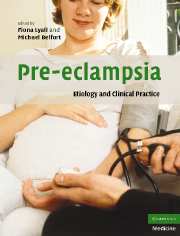Book contents
- Frontmatter
- Contents
- List of contributors
- Preface
- Part I Basic science
- Part II Clinical Practice
- 17 Classification and diagnosis of pre-eclampsia
- 18 Measuring blood pressure in pregnancy and pre-eclampsia
- 19 Immune maladaptation in the etiology of pre-eclampsia; an updated epidemiological perspective
- 20 Genetics of pre-eclampsia and counseling the patient who developed pre-eclampsia
- 21 Thrombophilias and pre-eclampsia
- 22 Medical illness and the risk of pre-eclampsia
- 23 The kidney and pre-eclampsia
- 24 Management of mild pre-eclampsia
- 25 Management of severe pre-eclampsia
- 26 The differential diagnosis of pre-eclampsia and eclampsia
- 27 Complications of pre-eclampsia
- 28 Central nervous system findings in pre-eclampsia and eclampsia
- 29 Pathogenesis and treatment of eclampsia
- 30 Anesthesia for the pre-eclamptic patient
- 31 Critical care management of severe pre-eclampsia
- 32 The role of maternal and fetal Doppler in pre-eclampsia
- 33 Pregnancy-induced hypertension – the effects on the newborn
- 34 Medico-legal implications of the diagnosis of pre-eclampsia
- Subject index
- References
26 - The differential diagnosis of pre-eclampsia and eclampsia
from Part II - Clinical Practice
Published online by Cambridge University Press: 03 September 2009
- Frontmatter
- Contents
- List of contributors
- Preface
- Part I Basic science
- Part II Clinical Practice
- 17 Classification and diagnosis of pre-eclampsia
- 18 Measuring blood pressure in pregnancy and pre-eclampsia
- 19 Immune maladaptation in the etiology of pre-eclampsia; an updated epidemiological perspective
- 20 Genetics of pre-eclampsia and counseling the patient who developed pre-eclampsia
- 21 Thrombophilias and pre-eclampsia
- 22 Medical illness and the risk of pre-eclampsia
- 23 The kidney and pre-eclampsia
- 24 Management of mild pre-eclampsia
- 25 Management of severe pre-eclampsia
- 26 The differential diagnosis of pre-eclampsia and eclampsia
- 27 Complications of pre-eclampsia
- 28 Central nervous system findings in pre-eclampsia and eclampsia
- 29 Pathogenesis and treatment of eclampsia
- 30 Anesthesia for the pre-eclamptic patient
- 31 Critical care management of severe pre-eclampsia
- 32 The role of maternal and fetal Doppler in pre-eclampsia
- 33 Pregnancy-induced hypertension – the effects on the newborn
- 34 Medico-legal implications of the diagnosis of pre-eclampsia
- Subject index
- References
Summary
Of the four dominant worldwide causes of maternal mortality (hemorrhage, infection, pre-eclampsia/eclampsia, obstructed labor), pre-eclampsia/eclampsia is the only one whose etiology remains poorly understood. Although the syndrome is now well defined (ACOG, 1996), it is clear that it represents a final common pathway for multiple etiologies. It is also a systemic disorder with potential effects on every organ system in the pregnant woman's body. As a result, pre-eclampsia could be expected to have many and varied presenting signs and symptoms, a reality known well to experienced clinicians. Indeed, the observation that “the most common multisystem disease in late pregnancy is pre-eclampsia” is truly germane to this discussion. On the other hand, women at any time in pregnancy may develop signs and symptoms of virtually any medical condition that might be otherwise unrelated to pregnancy.
A recent review has characterized the differential diagnosis of this syndrome based on the ACOG criteria for severe pre-eclampsia (Varner, 2002). It is thus the purpose of this chapter to examine the differential diagnoses that can mimic this pregnancy complication, with emphasis on those conditions more likely to be associated with clinically significant end-organ involvement. Because real-life clinical practice routinely distinguishes between symptoms and signs and incorporates these findings with laboratory and imaging results, this chapter will review each major organ system by symptoms, signs, laboratory findings and imaging findings, recognizing that some organ systems may not have any relevant findings.
- Type
- Chapter
- Information
- Pre-eclampsiaEtiology and Clinical Practice, pp. 380 - 405Publisher: Cambridge University PressPrint publication year: 2007



